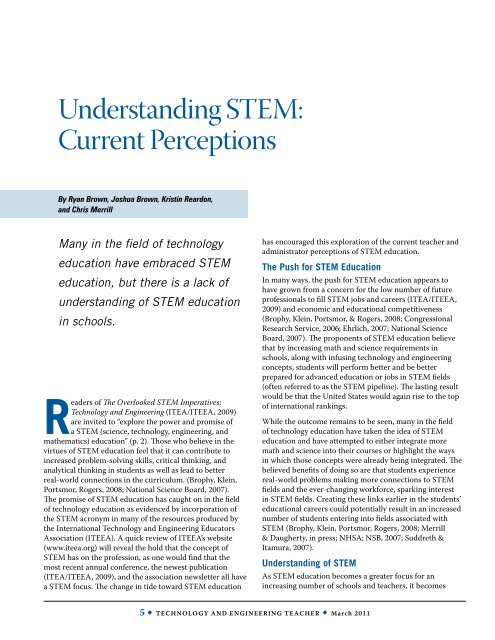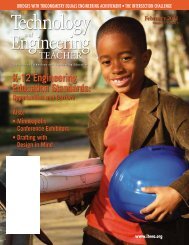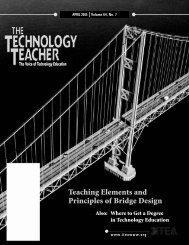March - Vol 70, No 6 - International Technology and Engineering ...
March - Vol 70, No 6 - International Technology and Engineering ...
March - Vol 70, No 6 - International Technology and Engineering ...
You also want an ePaper? Increase the reach of your titles
YUMPU automatically turns print PDFs into web optimized ePapers that Google loves.
Underst<strong>and</strong>ing STEM:<br />
Current Perceptions<br />
By Ryan Brown, Joshua Brown, Kristin Reardon,<br />
<strong>and</strong> Chris Merrill<br />
Many in the field of technology<br />
education have embraced STEM<br />
education, but there is a lack of<br />
underst<strong>and</strong>ing of STEM education<br />
in schools.<br />
Readers of The Overlooked STEM Imperatives:<br />
<strong>Technology</strong> <strong>and</strong> <strong>Engineering</strong> (ITEA/ITEEA, 2009)<br />
are invited to “explore the power <strong>and</strong> promise of<br />
a STEM (science, technology, engineering, <strong>and</strong><br />
mathematics) education” (p. 2). Those who believe in the<br />
virtues of STEM education feel that it can contribute to<br />
increased problem-solving skills, critical thinking, <strong>and</strong><br />
analytical thinking in students as well as lead to better<br />
real-world connections in the curriculum. (Brophy, Klein,<br />
Portsmor, Rogers, 2008; National Science Board, 2007).<br />
The promise of STEM education has caught on in the field<br />
of technology education as evidenced by incorporation of<br />
the STEM acronym in many of the resources produced by<br />
the <strong>International</strong> <strong>Technology</strong> <strong>and</strong> <strong>Engineering</strong> Educators<br />
Association (ITEEA). A quick review of ITEEA’s website<br />
(www.iteea.org) will reveal the hold that the concept of<br />
STEM has on the profession, as one would find that the<br />
most recent annual conference, the newest publication<br />
(ITEA/ITEEA, 2009), <strong>and</strong> the association newsletter all have<br />
a STEM focus. The change in tide toward STEM education<br />
has encouraged this exploration of the current teacher <strong>and</strong><br />
administrator perceptions of STEM education.<br />
The Push for STEM Education<br />
In many ways, the push for STEM education appears to<br />
have grown from a concern for the low number of future<br />
professionals to fill STEM jobs <strong>and</strong> careers (ITEA/ITEEA,<br />
2009) <strong>and</strong> economic <strong>and</strong> educational competitiveness<br />
(Brophy, Klein, Portsmor, & Rogers, 2008; Congressional<br />
Research Service, 2006; Ehrlich, 2007; National Science<br />
Board, 2007). The proponents of STEM education believe<br />
that by increasing math <strong>and</strong> science requirements in<br />
schools, along with infusing technology <strong>and</strong> engineering<br />
concepts, students will perform better <strong>and</strong> be better<br />
prepared for advanced education or jobs in STEM fields<br />
(often referred to as the STEM pipeline). The lasting result<br />
would be that the United States would again rise to the top<br />
of international rankings.<br />
While the outcome remains to be seen, many in the field<br />
of technology education have taken the idea of STEM<br />
education <strong>and</strong> have attempted to either integrate more<br />
math <strong>and</strong> science into their courses or highlight the ways<br />
in which those concepts were already being integrated. The<br />
believed benefits of doing so are that students experience<br />
real-world problems making more connections to STEM<br />
fields <strong>and</strong> the ever-changing workforce, sparking interest<br />
in STEM fields. Creating these links earlier in the students’<br />
educational careers could potentially result in an increased<br />
number of students entering into fields associated with<br />
STEM (Brophy, Klein, Portsmor, Rogers, 2008; Merrill<br />
& Daugherty, in press; NHSA; NSB, 2007; Suddreth &<br />
Itamura, 2007).<br />
Underst<strong>and</strong>ing of STEM<br />
As STEM education becomes a greater focus for an<br />
increasing number of schools <strong>and</strong> teachers, it becomes<br />
5 • <strong>Technology</strong> <strong>and</strong> <strong>Engineering</strong> Teacher • <strong>March</strong> 2011
















